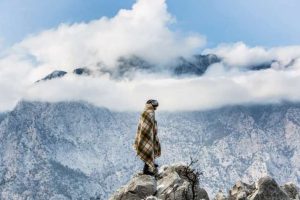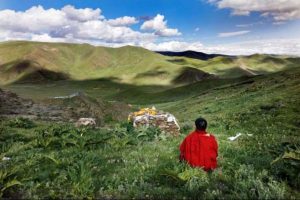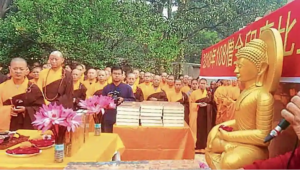
The Shozan engi, literally Mountain Stories of Origin, is a 12th century Shugendo document. This document constitutes the basis for a documentary film created by two sisters, Carina and Sandra Roth—one of only a few English-language documentaries on the topic of Shugendo.
Buddhistdoor Global had an opportunity to speak with Carina and Sandra about the making of this documentary and their fieldwork in Japan. This is the first part of a two-part interview.

BDG: What is the Shozan engi?
Carina: As Shugendo emphasizes practice over theory on the one hand and oral transmission on the other, written sources are scarce. The Shozan engi is among the oldest such rare documents.
It is a compilation of texts focusing on three mountain ranges on the Kii Peninsula. Its 20 chapters are extremely diverse in nature, including precise descriptions of rituals and of sacred landscapes, as well as legends of Buddhist, Daoist, and other origins.
One of the key features of the Shozan engi is its description of the Omine mountains as embodying the Womb World and the Diamond World mandalas, two fundamental mandalas of Esoteric Buddhism in Japan.

BDG: Who came up with the idea for this documentary? Why did you make it and who did you make it for?
Sandra: I read Carina’s MA dissertation during a trip through Japan and loved both the descriptions of the mountains in the Shozan engi and how it depicts [Shugendo founder] En no Gyoja’s travels through the Kii Peninsula.
My first idea was to create a short animated movie in the form of a travelogue, recalling the principle of emaki [an illustrated text or narrative combining text and pictures on a horizontal hand scroll. The oldest extant emaki dates to the eighth century].
As I enjoyed the cartographic precision of the Shozan engi, I wanted to use real images of the actual landscapes and create a spacious narrative—an interplay between mountain and text.
My intent was to create a treasure map using actual indications for a narrative that didn’t need actual geography. We planned out the project, and were fortunate to be awarded funding by the Swiss Japan Association. Fundamentally, it was an artistic project.

Carina: Shortly before our planned departure for Japan in the summer of 2004, I had a chance encounter with a Japanese lawyer here in Geneva who happened to be the lawyer for the Kyoto Temple Association. We met again in Kyoto and he introduced us to Miyagi Tainen, who is the patriarch of the Honzan branch, one of two main Shugendo branches, based at Shogoin temple in Kyoto.
Because the Kii region had obtained UNESCO registration that same year, Shogoin was organizing—for the first time since the Meiji period [1868–1912; a time when Shugendo experienced severe disruptions]—the full course of the Okugake, traversing the entirety of the Omine mountain range from Yoshino to Kumano.
It was too late for us to follow the group over the whole journey, but Miyagi Tainen and his son Taigaku kindly agreed to let us join them at various points along the way. Although the initial project had no documentary component, we were delighted and felt extremely privileged to be allowed to take part in this historic event.
Several other equally astounding encounters took place during our stay, which transformed the initial project of a short animated movie into a half-animated, half-documentary film.

BD: What is it that fascinates you about En no Gyoja?
Sandra: En no Gyoja is a rich and colorful figure. What interested me in particular was that he is depicted with negative aspects too; he’s not presented as a glamorous hero.
Carina: When studying Shugendo, it’s impossible not to encounter the figure of En no Gyoja, even more so on the Kii Peninsula, where he is present in so many places and under so many guises. What I especially like about him is that he tends to be perceived as very approachable, a constant companion/guardian, a familiar presence who is both stern and amicable.

BD: How did you decide to mix legend with contemporary history? How did you go about finding and approaching interviewees?
Sandra: The basis for the project was to transpose parts of the Shozan engi into the contemporary landscape as a way to reenact the text on its original ground.
In practice, this meant looking at contemporary Japanese mountains through the prism of a 12th century narrative. As Carina described it, the project evolved because of a synchronicity of events and encounters during our stay in Japan.
Our objective was mostly to create a different space, to offer tools to understand space differently through other dimensions and other perceptions. The character of semi-fiction, semi-reality gives shape to this otherness. The principal dynamic of the film is to show a space laden with human presence, but with a twist. In several other artistic projects that I did in and about Japan, I worked with transformed nature. In this case, I also really wanted to work with the idea of emaki, and had a strong visual attraction for the possibility of that type of expression.
Carina: The only planned visit and interview was that of [Shugendo monk] Tateishi Kosho, whom I had met a few years earlier, while doing research at Kyoto University on a Japanese governmental grant. All the other episodes in the film simply . . . happened.

Carina Roth is a senior lecturer and research fellow in the Department of East Asian Studies and La Maison de l’histoire at the University of Geneva and Switzerland. She specializes in the history and anthropology of Japanese religions, and is one of the editors of the recently published volume Defining Shugendo: Critical Studies on Japanese Mountain Religion. She is working on the figure of En no Gyoja as founder of Shugendo, as well as on the international expansion and development of Japanese rituals surrounding abortion and perinatal death (mizuko kuyo).
Sandra Roth is a visual artist and a Geneva Fine Arts School graduate. She specializes in animation as a tool for documentary storytelling. Where Mountans Fly, the film discussed here, relies, for example, on animation for the narrative parts. As a graphic animator, she has also realized numerous animations and audiovisual projects for museums and the Swiss television network. Her ongoing projects include a film on international finance mechanisms.
To contact Carina and Sandra, email: [email protected]
Images courtesy of Carina and Sandra Roth.
See more
Related features from BDG
Where Mountains Fly: A Shugendo Documentary, Part 2












